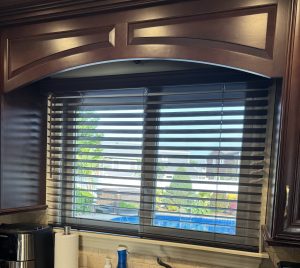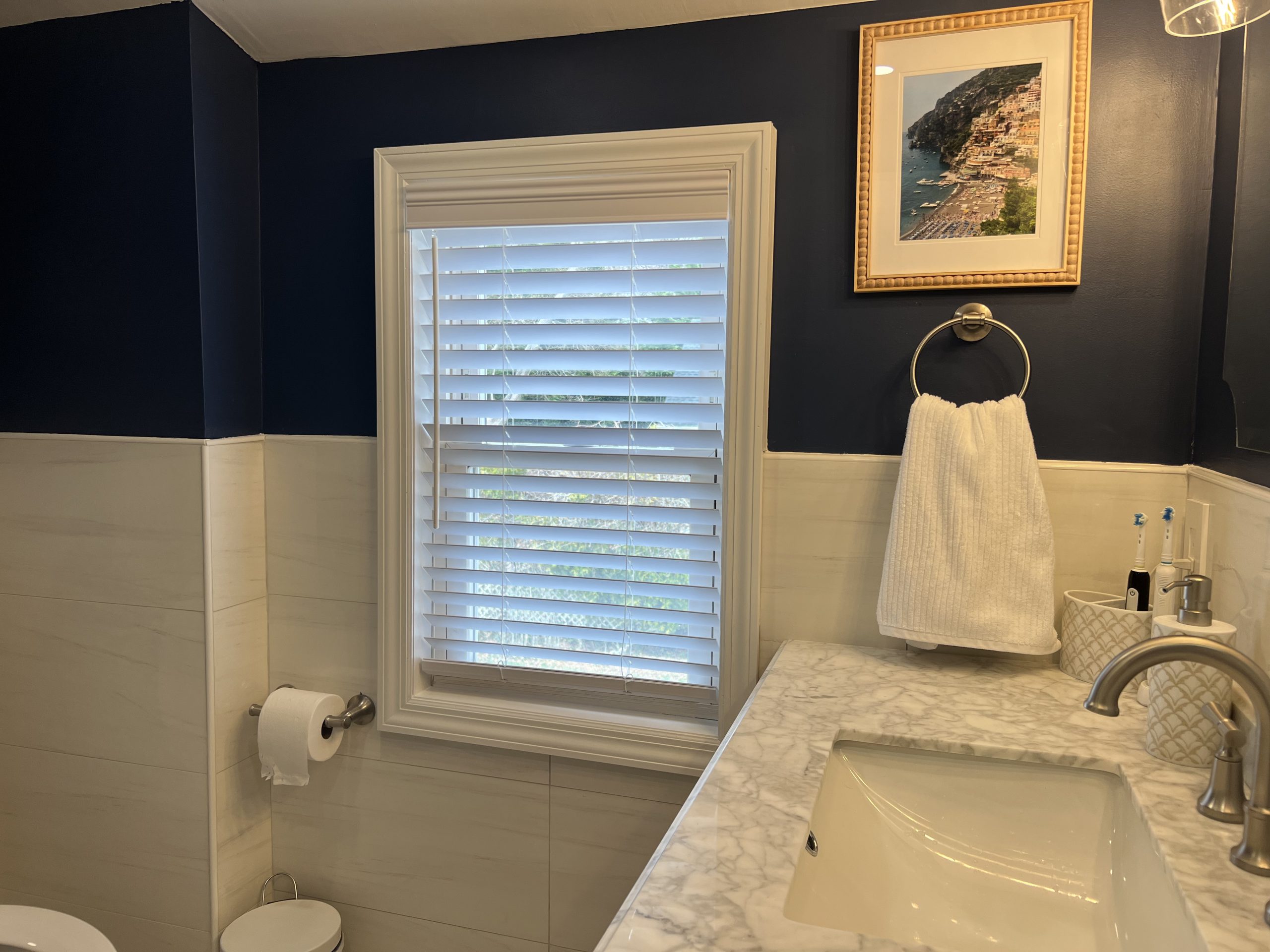Humidity ruins standard window treatments faster than most homeowners expect. Choosing the wrong material for your bathroom or kitchen windows leads to warping, discoloration, mold growth, and premature failure. This guide explains which materials survive moisture exposure and which ones don’t.

Why Humidity Destroys Standard Window Treatments
Bathrooms and kitchens generate significantly more moisture than other rooms in your home. Hot showers create steam that saturates the air, while cooking produces grease-laden vapor that settles on nearby surfaces. Standard window treatments absorb this moisture, causing structural damage over time.
When humidity levels regularly exceed 50-60%, wood materials begin to swell and contract with each moisture cycle. This constant expansion and contraction breaks down the wood fibers, warps slats, and compromises the structural integrity of blinds and shutters. Within 2-3 years, you’ll notice visible damage that only worsens with continued exposure.
Key humidity damage signs:
- Slats that won’t tilt smoothly or stay in position
- Visible warping, cupping, or bowing of individual slats
- Discoloration or water staining on the material
- Mold or mildew growth in corners or between slats
- Finish peeling, bubbling, or flaking off surfaces
Real Wood Blinds in Humid Spaces: When They Work (And When They Don’t)
Real wood blinds add warmth and natural beauty to any space, but they’re fundamentally incompatible with high-moisture environments. Even premium hardwoods treated with moisture-resistant finishes will eventually fail when exposed to consistent humidity levels above 60%.
The exception: half-baths or powder rooms without showers can accommodate real wood blinds successfully. These spaces lack the sustained moisture exposure that damages wood materials. If your bathroom includes a shower or bathtub that’s used regularly, avoid real wood entirely.
When to skip real wood:
- Full bathrooms with showers or tubs
- Kitchens located near stovetops or sinks
- Rooms without adequate ventilation or exhaust fans
- Windows directly adjacent to moisture sources
- Coastal homes with naturally high humidity levels
Faux Wood Blinds: The Moisture-Resistant Solution
Faux wood blinds consist of composite materials engineered specifically to resist moisture damage. Modern faux wood products use vinyl, PVC, or polymer compounds that don’t absorb water, making them ideal for humid environments. They maintain their shape and finish even with daily steam exposure.
Quality faux wood blinds replicate the appearance of real wood so convincingly that most people can’t distinguish them from across the room. They’re available in various wood-grain textures and stain colors that coordinate with any décor style.
Faux wood advantages in humid rooms:
- Zero moisture absorption prevents warping and swelling
- Easy to clean with damp cloths without damaging the material
- Resistant to mold and mildew growth
- Maintain structural integrity for 10-15 years in bathrooms
- Available in wood-grain patterns that mimic real wood aesthetics
Composite Materials: Advanced Humidity Protection
Composite window treatments represent the next evolution in moisture-resistant materials. These products combine multiple engineered materials to create window treatments that outperform both real wood and standard faux wood options in extreme conditions.
Premium composite shutters and blinds use materials like vinyl-coated wood cores, solid polymer construction, or advanced PVC formulations. They offer superior humidity resistance while maintaining the substantial feel and appearance of traditional wood products.
Composite material benefits:
- Enhanced durability in coastal or tropical climates
- Better insulation properties than standard faux wood
- Heavier, more substantial feel than basic vinyl blinds
- Superior color retention without fading from steam exposure
- Longer warranties reflecting manufacturer confidence
Room-Specific Recommendations
Different humid spaces require tailored approaches based on moisture intensity and exposure patterns.
For master bathrooms with daily shower use: Choose faux wood or composite blinds positioned at least 36 inches from the shower enclosure. Install an exhaust fan on a timer to reduce ambient humidity levels. Consider cellular shades made from moisture-resistant fabrics as an alternative for maximum privacy.
For kitchens with active cooking: Faux wood blinds work well for most kitchen windows. If windows are positioned directly beside the stovetop or sink (within 24 inches), composite materials offer additional protection against grease accumulation and heat exposure. Avoid fabric treatments near cooking surfaces.
For powder rooms without showers: Real wood blinds are acceptable in these lower-moisture environments. However, faux wood remains the safer long-term choice and eliminates concerns about occasional humidity spikes.
Red Flags: Signs Your Current Window Treatments Are Failing
Replace your bathroom or kitchen window treatments immediately if you notice:
- Slats that won’t stay tilted in position or drift slowly closed
- Visible warping where slats curve upward or downward
- White or gray spots indicating mold or mildew growth
- Difficulty raising or lowering blinds due to swollen components
- Discoloration spreading from edges toward the center
- Peeling finish or exposed raw material beneath the coating
- Musty odors emanating from the window treatments
These indicators signal that moisture has compromised the structural integrity. Continuing to use failing window treatments allows mold growth and creates health concerns.
Bottom Line Decision Framework
Choose faux wood blinds when:
- Installing treatments in any full bathroom with shower or tub
- Working with standard budgets for moisture-resistant solutions
- Covering multiple windows in humid spaces
- Seeking low-maintenance, long-lasting performance
Choose composite materials when:
- Living in coastal areas with naturally high humidity
- Upgrading to premium, long-term solutions
- Seeking enhanced insulation properties alongside moisture resistance
- Wanting the most durable option available for extreme conditions
Avoid real wood when:
- Any regular moisture exposure is present
- Room humidity regularly exceeds 55-60%
- Installing near showers, tubs, or cooking surfaces
Next Steps for Your Humid Room Window Treatment Project
Start by assessing the moisture levels in your bathrooms and kitchens. Note which windows are closest to showers, tubs, or cooking areas. Schedule a consultation with window treatment specialists who understand moisture-resistant materials. Long Island Custom Blinds offers expert guidance on selecting the right materials for your specific humidity conditions and provides professional measurement and installation services.
Request physical samples of faux wood and composite materials to examine their weight, texture, and appearance in your actual space. Ensure any quotes include detailed warranty information specifically addressing moisture-related damage. Proper material selection now prevents costly replacements and gives you window treatments that perform beautifully for years despite challenging humidity conditions.
